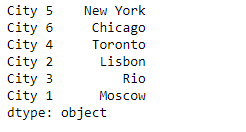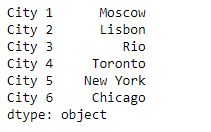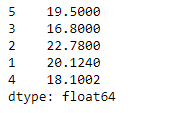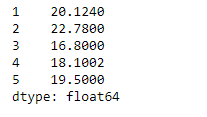Python Pandas Series.slice_shift()
Pandas系列是一个带有轴标签的一维ndarray。标签不需要是唯一的,但必须是一个可散列的类型。该对象支持基于整数和标签的索引,并提供了大量的方法来执行涉及索引的操作。
Pandas Series.slice_shift()函数等同于不复制数据的移位。移位后的数据将不包括删除的周期,移位后的轴将比原来的小。
语法: Series.slice_shift(periods=1, axis=0)
参数:
periods:移动的周期数,可以是正数或负数
返回:移位:与调用者的类型相同
例子#1:使用Series.slice_shift()函数将给定的Series对象的数据移动2个周期。
# importing pandas as pd
import pandas as pd
# Creating the Series
sr = pd.Series(['New York', 'Chicago', 'Toronto', 'Lisbon', 'Rio', 'Moscow'])
# Create the Datetime Index
didx = pd.DatetimeIndex(start ='2014-08-01 10:00', freq ='W',
periods = 6, tz = 'Europe/Berlin')
# set the index
sr.index = didx
# Print the series
print(sr)
输出 :

现在我们将使用Series.slice_shift()函数将给定的系列对象中的数据移动2个周期。
# shift by 2 periods
sr.slice_shift(periods = 2)
输出 :

正如我们在输出中看到的,Series.slice_shift()函数已经成功地将数据移到了索引上。注意到前两个索引标签被删除了。
示例#2:使用Series.slice_shift()函数将给定的Series对象的数据转移到-2期。
# importing pandas as pd
import pandas as pd
# Creating the Series
sr = pd.Series(['New York', 'Chicago', 'Toronto', 'Lisbon', 'Rio', 'Moscow'])
# Create the Datetime Index
didx = pd.DatetimeIndex(start ='2014-08-01 10:00', freq ='W',
periods = 6, tz = 'Europe/Berlin')
# set the index
sr.index = didx
# Print the series
print(sr)
输出 :

现在我们将使用Series.slice_shift()函数,将给定的系列对象中的数据移出-2期。
# shift by -2 periods
sr.slice_shift(periods = -2)
输出 :

正如我们在输出中看到的,Series.slice_shift()函数已经成功地将数据移到了索引上。注意到最后两个索引标签被删除了,数据被向上移动了。
 极客教程
极客教程